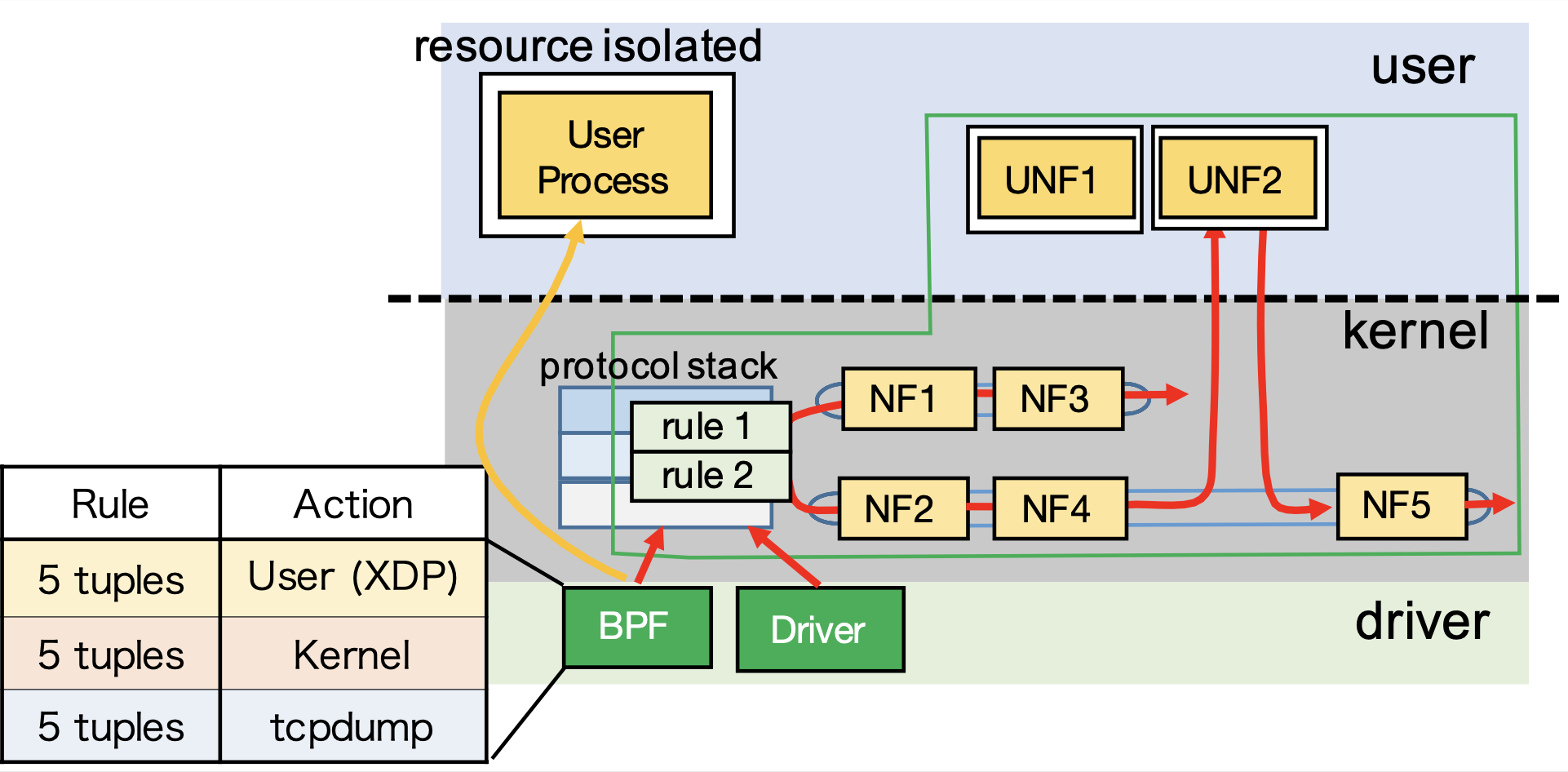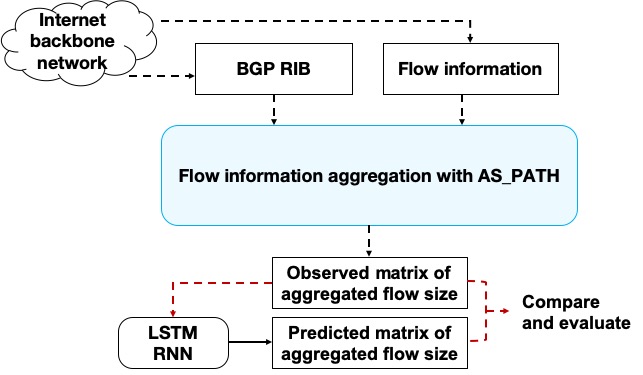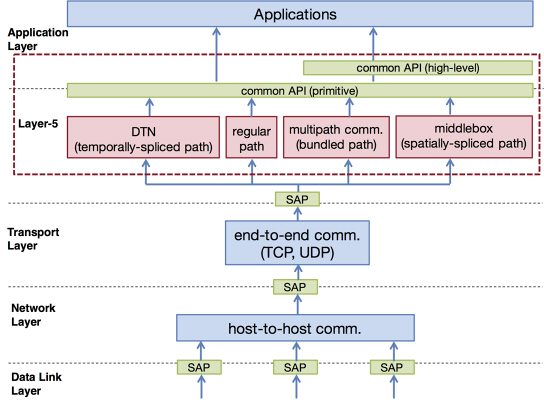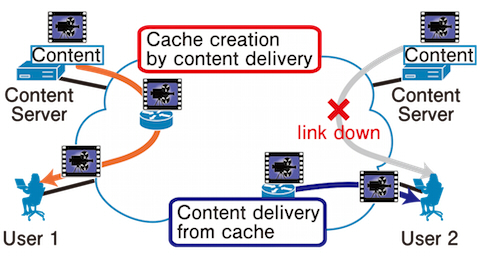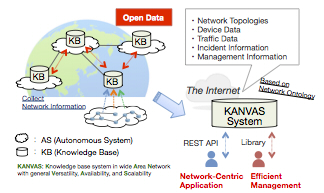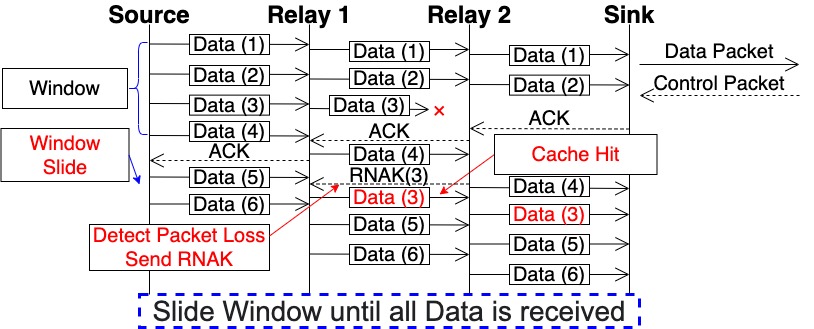LiON: A L3 Protocol Agnostic Experimental Network Construction Tool Based on Infrastructure as Code
An experimental network environment plays an important role to examine new protocols and systems. LiON (Lightweight On-demand Networking) is an IaC (Infrastructure as Code) based tool for constructing virtual networks on the Internet for various experiments. JSON (JavaScript Object Notation) is adopted as the configuration file format, which enables the experimenter to intuitively design virtual network topologies. Layer-3 protocol agnostic experimental networks can be constructed, which enable to examine non-IP protocol stacks.
Network Function Chaining Infrastructure Considering Cooperation between User space and Kernel space
Implementation of Network Functions (NF) as software realizes a flexible network, but there is overhead of memory copying and calculation resource consumption. We propose a lightweight Network Function Chaining (NFC) architecture considering cooperation between user space and kernel space. Lightweight NF is placed in the kernel space to reduce the overhead. NF that uses advanced libraries or occupies resources is placed in the user space to separate resources. We implemented the proposed architecture in the Linux kernel. NFs are managed in the pool. NFC is configured with NFs in the pool. A mechanism for incorporating NFC into packet processing is implemented in both user space and kernel space. We are studying Network Function Chaining Infrastructure that considers security and optimal allocation of NF using eBPF, XDP, Intel MPI, etc. for a multi-tenant environment.
A Mechanism for Simplifying VNF Implementation for Privacy Protection and Efficient Data Transfer Using SmartNIC
Network Function Virtualization (NFV) decouples Network Functions (NFs) from dedicated hardware and realizes their flexible placement. Although NFs are implemented on software and programable hardware, few NFs realize both high speed processing and practicality. On the other hand, increasing privacy attacks against NFs observed these days results in social demands for privacy protection because the attacks can leak personal information. By offloading the user space VNF processing to SmartNIC, it is possible to reduce the overhead of simple processing and processing common to multiple user space VNFs. Additionally, encrypting payload or extracting the necessary part of the packet before passing the packet to VNFs in the user space realizes privacy protection.
Data Analysis for Network
GAMPAL: Anomaly Detection for Internet Backbone Traffic by Flow Prediction with LSTM-RNN
GAMPAL (General-purpose Anomaly detection Mechanism using Path Aggregate without Labeled data) is an anomaly detection mechanism for Internet backbone traffic. GAMPAL does not require labeled data to achieve a general-purpose anomaly detection. For scalability to the number of entries in the BGP RIB (Routing Information Base), GAMPAL introduces path aggregates. The BGP RIB entries are classiffied into the path aggregates, each of which is identiffied with the first three AS numbers in the AS PATH attribute. GAMPAL establishes a prediction model of traffic throughput based on past traffic throughput. It adopts the LSTM-RNN (Long Short-Term Memory Recurrent Neural Network) model focusing on periodicity in weekly scale of the Internet traffic pattern.
A Service Traffic Prediction Method from ISP’s Perspective
Predicting traffic flow accurately from ISP’s (Internet Service Providers) perspective enables to provide TE (Traffic Engineering) for a long period. In addition, there is a demand to ISP for providing TE according to the characteristics related to services such as Youtube. We propose the mechanism which identifies the IP addresses related to services using the TCP/IP header information and the dwell time of webpage, and a service traffic prediction method to enable TE according to the characteristics of services. This mechanism can deal with complicated network systems such as CDN (Content Delivery Network) and TLS (Transport Layer Security) encryption.
New Generation Network Architecture
ZNA
ZNA (Z Network Architecture) is a new generation network architecture for the future internet. ZNA has a six-layered architecture, which has Layer-5 between application layer and transport layer. As other features, ZNA has ID/Locator-split protocol called ZNP (Z Network Protocol), the support for mobility and multihoming by ZNP, and the inter-node cross layer cooperation.
Layer-5 in ZNA
In ZNA, Layer-5 (L5) privides with applications with highly functional communication paths (L5-paths) such as a L5 bundled path as a model of multipath that bundles multiple L4-paths for bandwidth aggregation or fault tolerance, a L5 spatially-spliced path as a model of a path with middleboxes that splices spatially-divided L4-paths at a middlebox, and a L5 temporally-spliced path as a model of a path for delay tolerant communication that splices L4-paths not existing at the same time.
Information-Centric Networking
ZINK: Information-Centric Networking Based on Layered Network Architecture
ZINK is an information centric networking mechanism on ZNA focusing on content retrieval by a server-location independent content name considering the current Internet usage. It realizes fast and highly available content retrieval and traffic reduction in the network core by choosing content delivery servers dynamically.
Knowlege Base System in Wide Area Network
KANVAS
KANVAS (Knowledge base system in wide Area Networks with general Versatility, Availability and Scalability) is an open data oriented information sharing infrastracture based on knowledge base technology. It opens up another world of network management such as inference of failure causes using network knowledge ontology and better communication quality considering network situation.
Internet Access in High-speed Trains
The broadband Internet in trains
To provide broadband Internet connectivity to passengers in a high speed train, we study a network system using infrared communication and mobile IP technology. In particular, we analyze appropriate network topologies by simulations and develop a handover method with fewer packet loss.
Wireless Sensor Networks
RBCP: Fast Bulk data Collection Protocol with Multi-Path in WSN
With the increase in IoT devices in recent years, there has been increasing interest in Wireless Sensor Networks (WSN). Existing WSN collect sensor values but to monitor natural disasters, image data need be collected. Image collection is difficult with Low Power Wide Area (LPWA) such as LoRa, which is often used in WSN. Therefore, we assume a Wi-Fi multi-hop environment. RBCP supports multipath. RBCP realizes reliability and high-speed transfer by using the cache at the relay node.
Communication Protocol for 5G
Current mobile core networks manage each mobile terminal individually, and do not support terminal mobility collectively. This research proposes a method that manages a set of terminals as a mobile network (moving cell) efficiently by prefix delegation or ID/Locator-split.

